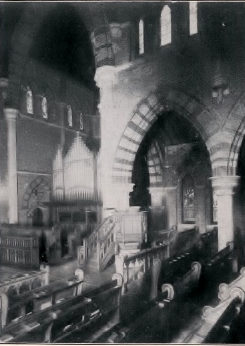SHA1883
| Census ID | SHA1883 |
|---|---|
| Location | Shanghai, Holy Trinity Cathedral; later moved to St. Ignatius, Zikawei |
| Builder | Walker No. 1158 |
| Specs | III/32+ Ped. (later 34) |
| Action | Mechanical |
| Note: | Previouly numbered SHA1883a |
At the time of its installation in 1883, Walker No. 1158 was the largest pipe organ yet erected in China. Several builders had been approached for the contract, including William Hill and Sons; but the contract was eventually awarded to Walker in 1881. Prior to being sent out to China, two recitals were played on the organ in London, one by Sir Frederick Bridge (1844-1924), organist of Westminster Abbey, and the other by Dr. F.E. Gladstone (1845-1928.) The organ was housed in a free-standing case (see main picture) and was hand-blown.
The earlier Gray and Davison organ (SHA1856) in Holy Trinity Cathedral had long required replacing, and was overhauled by Walker in 1883 and reinstalled in the Masonic Hall, possibly utilizing some pipes from SHA1863b. All this activity was due to the industry of the organist of Holy Trinity from 1878 to 1886, George Benjamin Fentum (1843-1914). For more information about Fentum, see the post on What’s New for 13 May 2020.
When erected, SHA1883a had the following specs:
| Great (58 notes) |
Double Diapason 16′ Open Diapason 8′ Horn Diapason (façade) 8′ Waldflöte 8′ Principal 4′ Harmonic Flute 4′ Twelfth 2 2/3′ Fifteenth 2′ Mixture III Posaune 8′ |
| Swell |
Bourdon 16′ Open Diapason 8′ Echo Gamba 8′ (wood bass) Vox Angelica (to Tenor C) 8′ Stopped Diapason 8′ Principal 4′ Harmonic Piccolo 2′ Mixture III Sharp Mixture II Horn 8′ Vox Humana 8′ Clarion 4′ |
| Choir |
Salicional 8′ Dulciana 8′ Lieblich Gedact 8′ Flute 4′ Piccolo 2′ Clarionet 8′ |
| Pedal (30 notes) |
Open Diapason 16′ Bourdon 16′ Quint 12′ Principal 8′ |
| Accessories | Tremulant (SW), 3 Composition Pedals (GT), 3 Composition Pedals (SW), |
| Couplers | SW/G, SW/Ped, GT/Ped, CH/Ped, SW/CH, Superoctave SW/CH |
The climactic problems that affected the Gray and Davison organ (SHA1856) had not, however, been solved by the builder. It was overhauled and cleaned in 1889 and 1897. In 1904 it was slightly enlarged: the Great 16′ Double Diapason was replaced by a Bourdon 16′, and the Twelfth was replaced by a 4′ Clarion. In the Pedal division, the Quint was removed, and a 16′ Trombone and an 8′ Flute added. The Trombone was later said to be of the “German type, and most unsatisfactory.” There was a final overhaul in 1908, when the straight pedal board was replaced by a concave one.
SHA1883 was in use until after the First World War (when it was replaced by SHA1925.) At this time it was sold to the Jesuits (who had bought it for 3,500 taels) and, rebuilt by Harrison and Harrison, it was re-installed in the Cathedral of St. Ignatius at Zikawei, completed in 1910 (see photos below.) This organ apparently survived until 1966, and is presumed to have been destroyed in the sack of the Cathedral by Red Guards on 24 August 1966.
In the Census (Appendix) to Keys to the Kingdom, this organ is listed as a 35-stop instrument, but this is an error. The stop list is correctly given in the text.
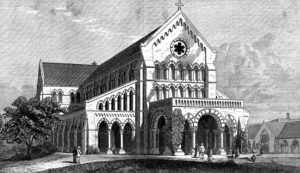
Holy Trinity Cathedral, shortly after its initial erection (the bell tower was not added until 1903.)
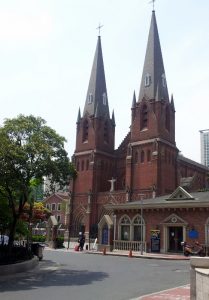
The Cathedral of St. Ignatius, Zikawei, completed in 1910. This was the final home of SHA1883 from 1925 to 1966.
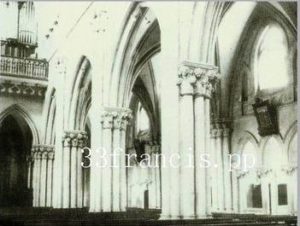
Zikawei in the late 1920s or 1930s. A small part of SHA1883 in its new location can be seen at upper right.
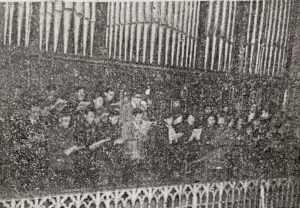
SHA1883 in 1956, with the choir (presumably Easter Mass). Kindly provided by the Tushanwan Museum.
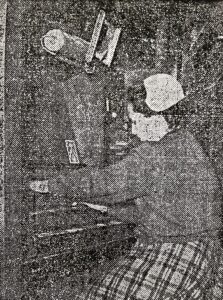
An organist at the console of SHA1883, Christmas 1955. Kindly provided by the Tushanwan Museum.
